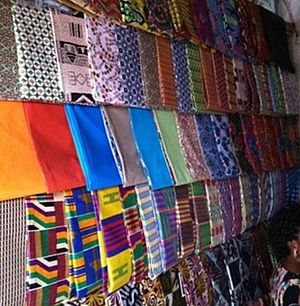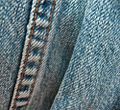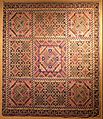Textile facts for kids
Cloth, textile, and fabric are all words for materials made by people. These materials are usually created by weaving or knitting tiny threads called fibres together. We use cloth for many things, like making clothing or covering furniture.
Cloth can be made from two main types of fibres: natural or man-made. Natural fibres come from plants or animals. Think of cotton, wool, and silk. Man-made fibres are created in factories. Some examples are nylon, rayon, and polyester.
Contents
History of Cloth
People started wearing clothes a very long time ago, at least 70,000 years ago, maybe even earlier! The first clothes were probably made from animal skins. These helped early humans stay warm and safe from the weather. Later, people learned how to weave plant fibers to create textiles. This was a big step in making different kinds of cloth.
What We Use Cloth For
Textiles are super useful! Most commonly, we use them for clothing. But they are also used to make containers like bags and baskets.
Around the house, you'll find textiles in many places. They are used for carpets, soft furniture covers, window shades, towels, and coverings for tables and beds. Textiles are also used in art and crafts.
In other areas, textiles have special jobs. They are used in industrial and scientific jobs, like for filtering things. You can also see them in flags, backpacks, tents, nets, and cleaning rags. Even in transportation, textiles are important for things like balloons, kites, sails, and parachutes.
Textiles also make other materials stronger. For example, they are used in composite materials like fibreglass. Many traditional crafts use textiles, such as sewing, quilting, and embroidery.
Types of Fibres
Textiles are made from many different materials. The fibres used to make them come from four main sources:
- Animals (like wool and silk)
- Plants (like cotton and flax)
- Minerals (like glass fibre)
- Synthetic materials (like nylon and polyester)
The first three are natural sources.
Animal Fibres
Many different animals give us fibres for cloth:
- Wool comes from the hair of domestic sheep or goats. It's special because each strand has tiny scales and a natural oil called lanolin. Wool is great for warm clothes.
- Some examples of wool from other animals include Alpaca wool, vicuña wool, llama wool, and camel hair. These are often used for warm coats, jackets, ponchos, and blankets.
- Cashmere, from the Indian cashmere goat, and mohair, from the North African angora goat, are known for being super soft.
- Angora is the long, soft hair from the angora rabbit.
- Qiviut is a very fine wool from the muskox.
- Sea silk is a very rare and valuable fabric. It comes from silky threads made by a type of sea shell.
- Silk is an animal textile made from the fibres of the cocoon of the Chinese silkworm. It is spun into a smooth, soft fabric. Most silk today comes from farmed silkworms.
Plant Fibres
Plants provide many fibres for textiles:
- Coir is a fibre from coconuts. It's used to make twine, doormats, brushes, and mattresses.
- Straw and bamboo are often used to make hats. Straw is dried grass. Both straw and kapok are also used for stuffing.
- Fibres from pulpwood trees, cotton, rice, hemp, and nettle are used to make paper.
- Cotton, flax, jute, hemp, modal, and even bamboo fibre are all used to make clothing. Other clothing fibres include piña (from pineapple) and ramie.
- Acetate is a plant-based fibre that makes fabrics like silks and velvets look shinier.
- Seaweed can also be used to make textiles.
- Rayon is a fabric made from plant pulp.
Mineral Fibres
Minerals also give us fibres:
- Asbestos and basalt fibre are mineral fibres. They were used in things like vinyl tiles, ceiling tiles, stage curtains, and fire blankets.
- Glass fibre is used for ironing board covers, ropes, and cables. It also makes composite materials stronger and is used for flame-retardant and insulating fabrics.
- Metal fibre, metal foil, and metal wire are used for many things, including special fabrics like cloth-of-gold and jewellery.
Synthetic Fibres
Synthetic fibres are man-made:
- Polyester fibre is used in all kinds of clothing, either alone or mixed with natural fibres like cotton.
- Aramid fibre (like Twaron) is used for clothes that resist flames, protect against cuts, and even in armour.
- Acrylic is a fibre that looks and feels like wool. It's often used instead of wool in some clothes.
- Nylon is a fibre that looks like silk. It's used to make pantyhose. Thicker nylon is used for ropes.
- Spandex is a stretchy material used in activewear, bras, and swimsuits.
- Olefin fibre is used in activewear, linings, and warm clothes. Olefins dry quickly because they don't absorb water.
- Ingeo is a fibre made from plants (polylactide). It's mixed with other fibres like cotton for clothing and absorbs water.
- Lurex is a shiny metallic fibre used to decorate clothes.
- Milk proteins have also been used to make a synthetic fabric. It's a special fibre that can break down naturally and can be renewed.
- Carbon fibre is mostly used in composite materials with resin. These fibres are made from polymer fibres through a process called carbonization.
Gallery
-
Corduroy is a strong kind of cloth
Images for kids
-
Fabric shop in canal town Mukalla, Yemen
-
Mrs. Condé Nast wearing a silk Fortuny tea gown
-
A weaving shed of the Finlayson & Co factory in Tampere, Finland in 1932
-
Close-up view of a Barong Tagalog made with piña fiber in the Philippines
-
Embroidered skirts by the Alfaro-Nùñez family of Cochas, Peru, using traditional Peruvian embroidery methods
-
A double ikat weaving made by the Tausug people from Sulu, made of banana leaf stalk fiber (Abacá)
See also
 In Spanish: Tejido (textil) para niños
In Spanish: Tejido (textil) para niños
















